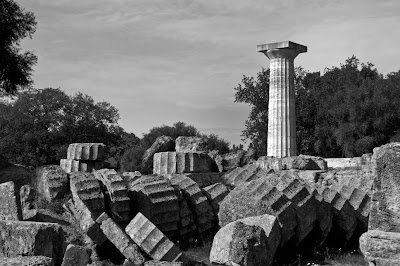My Life in Ruins, Part 3: Ancient Olympia
The next morning I headed out on my looooooong drive to Ancient Olympia on the Peloponnese, the big almost-an-island-but-technically-a-peninsula piece of land that makes up most of the southern mainland of Greece.
In order to cross the Gulf of Corinth, I took the Rio-Antirio Bridge. Yes, the towns on opposite sides of the Gulf are called “Rio” and “Antirio”. I suppose that makes a more exciting pair of city names than Minneapolis and St. Paul…but I digress. Opened just in time for the 2004 Olympic torch relay to Athens, it is the world's longest multi-span cable-stayed bridge. I’m not sure what that means but regardless it was a cool bridge.
Unsafe taken-while-driving photos!
After a good night’s sleep I was ready to spend the day exploring Ancient Olympia. This sanctuary was dedicated to Zeus and became one of the most important centers of worship in ancient Greece. Of course it is best known for the Olympic games, which were held here in honor of Zeus every 4 years beginning in 776 BC. The Heraia—women's games in honor of Hera—were also held.
The girth of its toppled columns gives you an idea of how mighty the Temple of Zeus at Olympia must have been—it is considered the ideal example of the Doric order. The temple also contained a 43-foot high, gold-and-ivory statue of a seated Zeus, which was one of the 7 Wonders of the World—but like the temple itself it was destroyed by various Romans, earthquakes, and fires around 500 AD. One column of the temple has been resurrected on the site, and it appears that they maybe be working on more.
Here’s an idea of what it looked like in better times, as well as the statue inside:
Inside the museum at Olympia, the two pediments that once adorned the temple have been impressively reconstructed in a giant hall.
In only slightly better shape—and no less impressive—is the temple dedicated to his wife, Hera.
The altar in front of the Temple of Hera is where the Olympic flame is ignited to this very day.
A bit of background…in ancient times, a flame was kept burning during the Olympic games to honor Zeus. This tradition was re-introduced at the 1928 Olympics in Amsterdam. The idea of the torch relay began with the 1936 Summer Games, when a torch was lit using the sun’s rays at the Temple of Hera in Olympia (by actresses recreating the ancient ceremony) and then relayed by runners all the way from Olympia to the opening ceremony in Berlin. Of course this tradition continues today, on an even bigger scale. In fact, here’s a clip of the lighting ceremony just held on May 10th to light the torch for this summer’s Olympics in London. It’s amazing to me to watch this now, clearly recognizing that I was just right there! (Click to play)
This passageway is called the “Crypt of Olympia”—it is a long and narrow vaulted passage through which the athletes and judges entered the Stadium, signifying the opening of the games:
The long, dirt field of the stadium is surrounded by slopes on which the spectators sat. Now it is where the torch begins its journey in a handoff to an athlete, and for the 2004 Athens Games the shot put competition was held here as well.
Remains of the Palaestra, part of the gymnasium where athletes would have practiced boxing, wrestling, and jumping:
Remains of the Philippeion, an ivory and gold memorial erected by King Philip II in 338 BC and finished by his son, Alexander the Great:
The remains of the Leonidaion, where the athletes lived while participating in the games the first Olympic Village, if you will):
This is the famed “Praxiteles Hermes”, a statue of Hermes and the infant Dionysus found in the ruins of the Temple of Hera. Made by the sculptor Praxiteles, it was remarkably well preserved by the thick, clay-like soil:
Inside the museum was also an extensive collection of ancient Greek helmets…
…and this tiny statue of Zeus that I enjoyed. He’s supposed to be holding a lightning bolt but I think it looks more like a banana:
This was the workshop of the sculptor Phidias, where he created the giant statue of Zeus. It was later converted into a Christian basilica:
And here’s a random lizard!
Next up…more ancient sites in Sparta, Mycenae, and Corinth. BUT BEFORE WE GO…A FEW PARTING SHOTS!
For some reason I enjoyed the idea that you MIGHT “need” to bring animals to “enjoy your visit and relaxation”:
And of course, some classy black-and-white shots.
Next stop, Sparta!





















































































